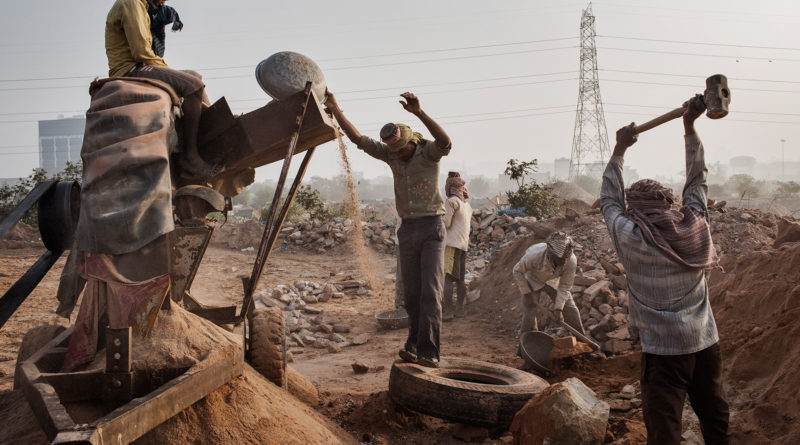Health Hazards of Construction
Construction workers run the risk of developing several health and work related problems. The industry has to adopt adequate safeguards to provide their workforce with safe and congenial working conditions
By Dr Suneela Garg / Dr.Anshul Shukla
The range of health disorders among industrial workers leading to absence from work is well documented and it has been recognised that construction workers are at greater risk of developing certain health disorders as compared to the general population and workers in other industries.
The various occupational exposures to which construction workers may either or have been subjected to include exposure to various forms of chemicals, cement, dust, smoke, heat, cold, noise and many more.
There are only a few industries as hazardous as construction work. Work at elevation, work involving heavy overhead loads, operation of heavy machinery and power tools, confined space work, temperature extremes and material handling demands combine to increase the risk of injuries. The construction industry is one of the most accident-prone industries, and workers may have fatal injury, hospitalization, and disability. Construction-related industrial accidents, in particular, comprise a high percentage of serious occupational injuries. The most common causes of major injuries are falls from height, slips, trips or falls on the level, and being struck by a moving/falling object.
Construction is a very stressful environment to work in. Causes are numerous that include aspects such as the physical environment, the actual organization itself, the way the organization is managed overall, personal relationships between workers, their own environment and the organization, as well as personal and social relationships and personal anxieties. Further, the heart disease, depression and anxiety, low self-esteem and burnout are a number of negative outcomes of such stress and stressors.
The workers might have different occupational diseases due to exposure to work. Some of the commonly encountered problems have been identified as follows:
Musculoskeletal Disorders
Construction workers are especially prone to Work-Related Musculoskeletal Disorders (WRMDs), they result in persistent pain, loss of functional capacity and work disability. Heavy weight lifting has been consistently described as a risk factor of back pain in occupational studies, but whole body vibration, bending, kneeling, smoking, and psychosocial stress have also been identified as risk factors.
Hearing And Ear Disorders
Among construction workers hearing deficiencies caused by noise have been one of the most common occupational diseases. Disorders of the ear can affect the workers fitness for work in several ways. Hearing difficulty, tinnitus, ear discharge and posture disturbances, and auditory disorders, particularly noise induced hearing loss (NIHL) have become common problems throughout the industry. Due to the frequent use of noisy machinery such as mechanical saws, compressors, grinding machines, drills, and other cutting tools, the construction workers’ exposure to noise is remarkably high.
These adverse effects of noise exposure may include sleep disturbance, irritability, stress, tension, distraction, risk of ischemic heart disease, influence on quality of life, interference with communication, health and well-being outcomes, behavioural and mental health effects and diminished performance.
Respiratory Problems
Respiratory diseases pose many special problems at work that differ according to the nature of the disorder and the workplace. Unskilled workers, carpenters, and bricklayers have the highest prevalence of abnormal findings in the lungs, which may indicate an obstructive lung disease such as bronchitis, obstructive emphysema and/or asthma. Smoking, air pollution, recurrent infections of the airways, climatic conditions, and socioeconomic factors are mainly considered responsible for developing such diseases. The inhalation of dust is very common in construction workers leading to continuous irritation of the mucosa.
Skin Disorders
Occupational diseases of the skin are common among construction workers.
Of all the occupational dermatoses, contact dermatitis is the most prevalent, comprising 20-90% of all the cases. In the construction industry, various categories of workers are involved such as masons, helpers, fitters, supervisors, carpenters and painters. The usual irritants and sensitizers in the construction industry are as folllows
Irritants: Cement, chalk, fly ash, hydrochloric and hydrofluoric acids, fiberglass, rockwool, wood preservatives
Sensitizers: Cement and fly ash, chromate, cobalt, epoxy resin, rubber, leather gloves, adhesives (phenol or urea-formaldehyde resins), wood preservatives, fiberglass impregnated with phenol-formaldehyde, epoxy and polyurethane resins, jointing materials
Cardiovascular System
There are many risk factors for CHD of non-occupational origin, which include hypertension, smoking, diet, hypercholesterolemia and obesity. These risk factors can work in a synergistic way with occupational stress which increases the risk of developing this disease.
Substance Use
Cigarette smoking is the most important preventable factor contributing to increased morbidity and mortality due to a number of diseases such as cancer and other diseases of the lung, such as chronic obstructive pulmonary disease, emphysema and pneumonia. In addition, smoking is a risk factor for malignant tumours of the pharynx, oral cavity and the urogenital bladder. Smoking of cigarettes also increases the risk of cardiovascular diseases such as myocardial infarction, stroke and arteriosclerosis.
Among construction workers, the risk of respiratory diseases may further be elevated by smoking in addition to occupational factors, such as exposure to dust. The strong association of smoking with occupational disability due to respiratory diseases among workers with pre-existing respiratory disease might point to potential synergistic effects with other factors such as occupational dust exposure, and they underline the particular importance of promotion of smoking cessation in this occupational group.
The Recommendations to tackle these problems are as follows –
Social Protection and Insurance
Health Education of Construction Workers
Organization of Construction Workers and Awareness about Existing Schemes.
Regular Medical Examination and Health Checkups of Construction Workers
Raise the Education Status of Construction Workers .
(The authors are from the Department of Community Medicine, Maulana Azad Medical College, New Delhi)



